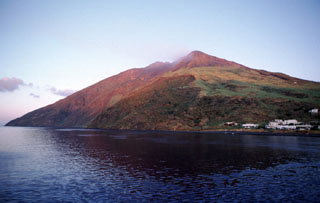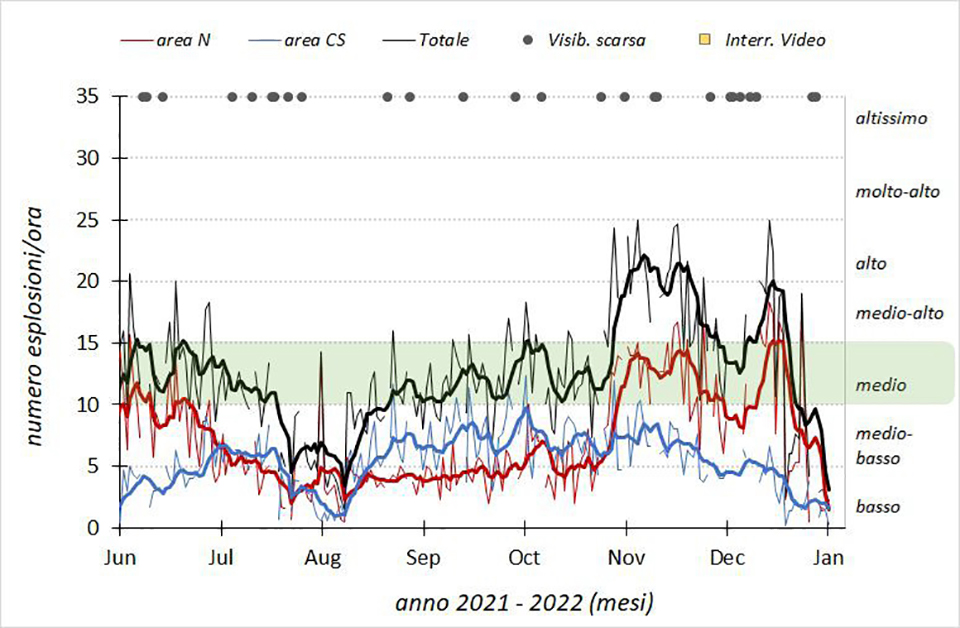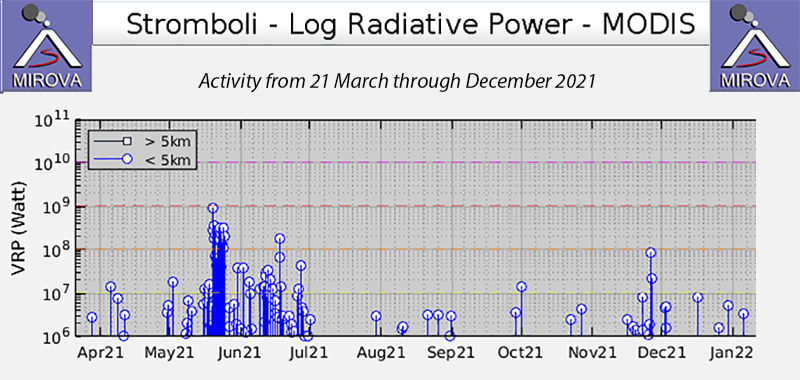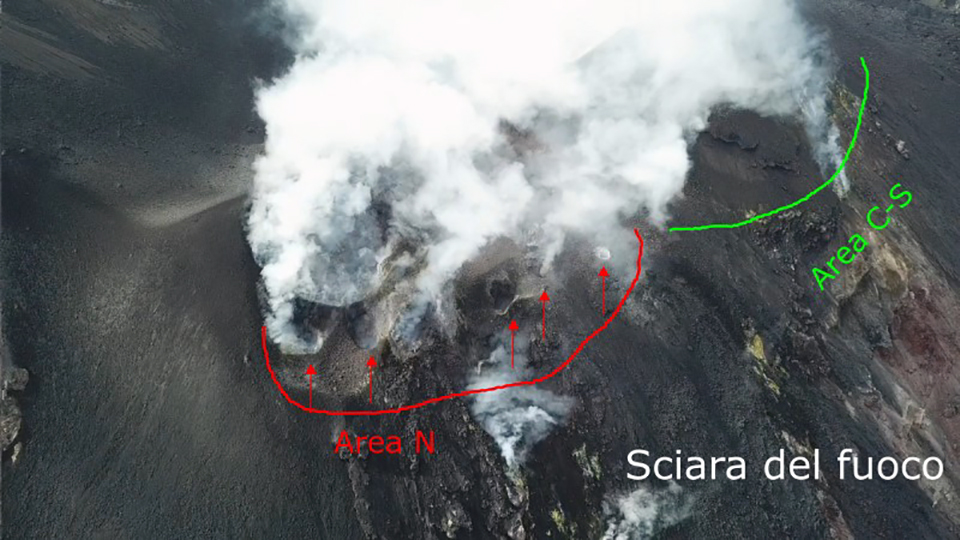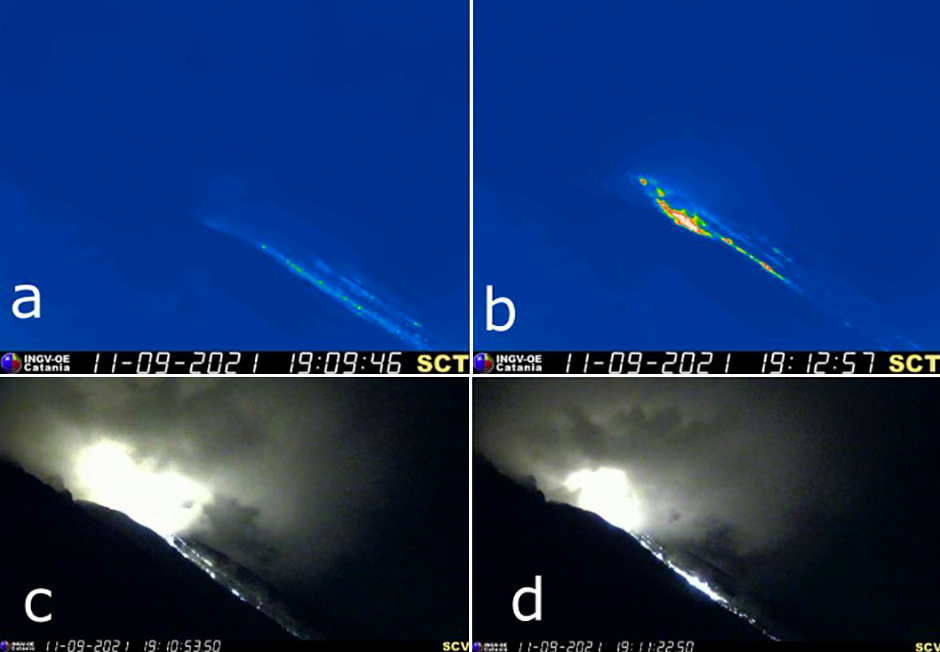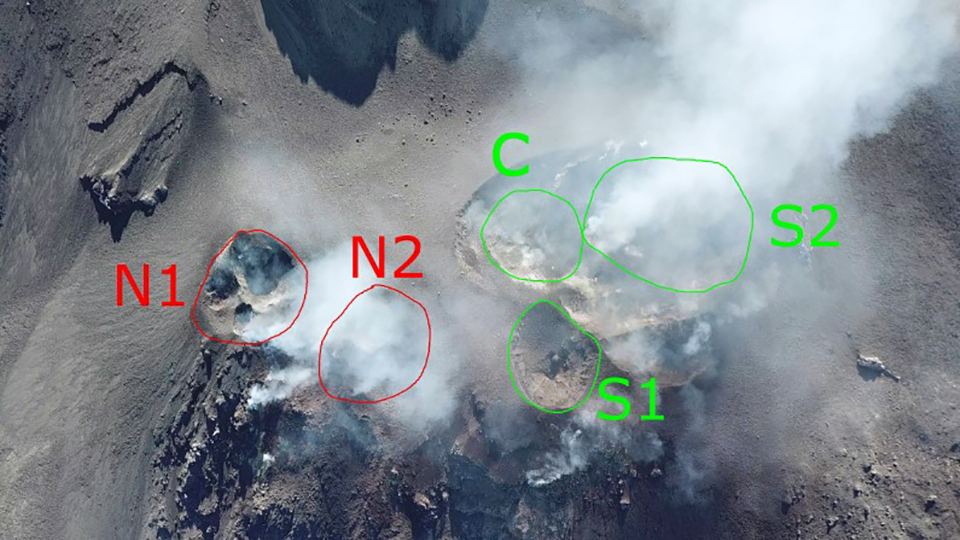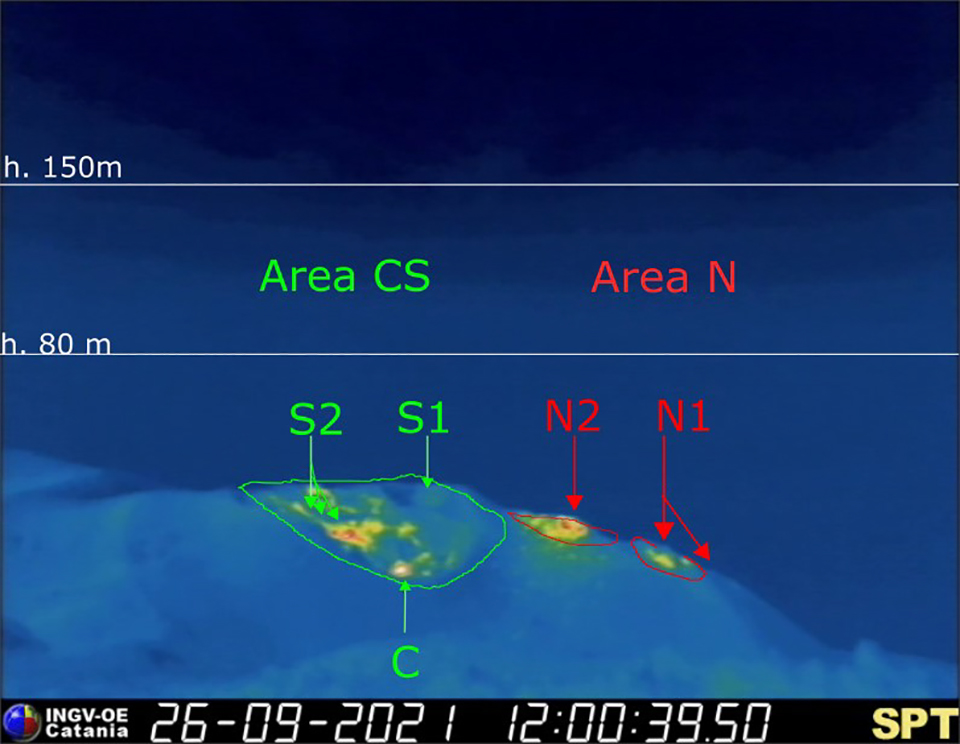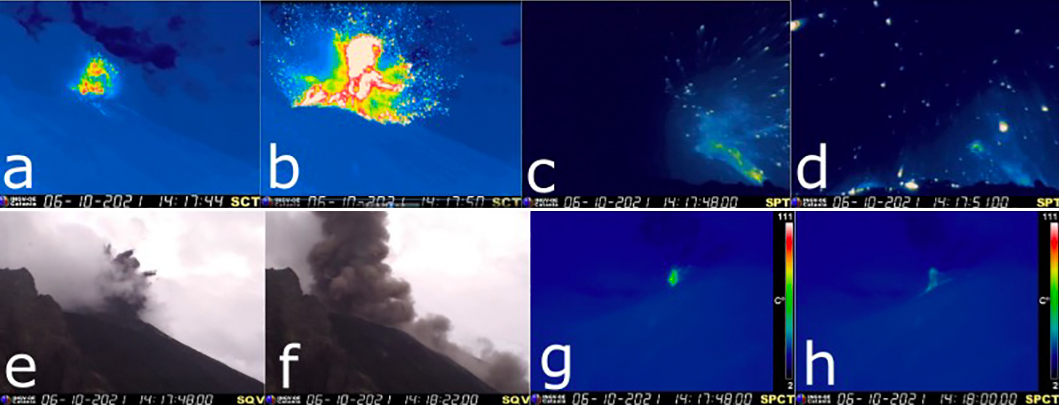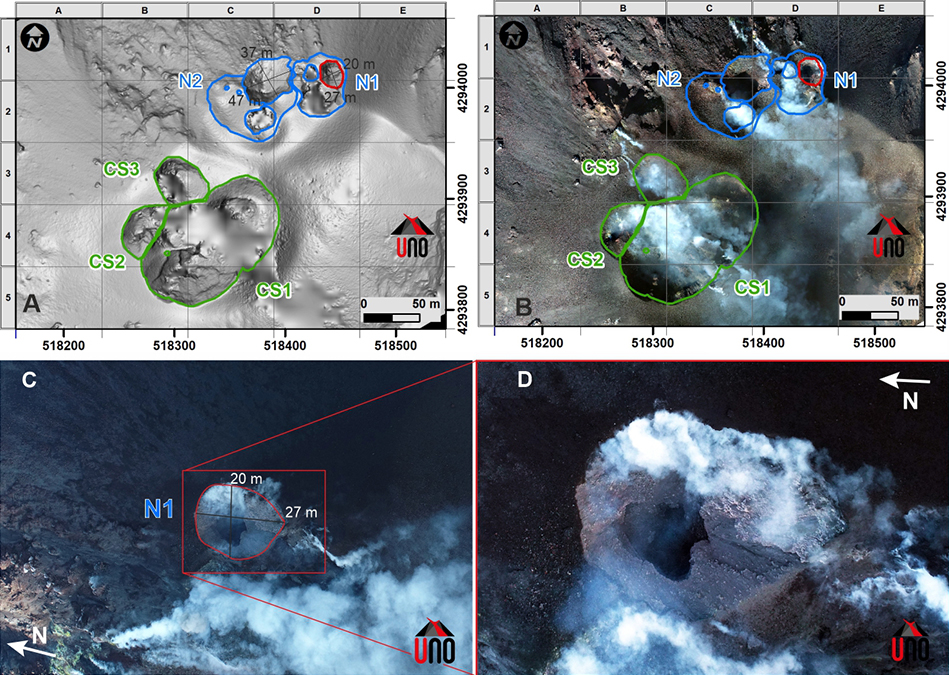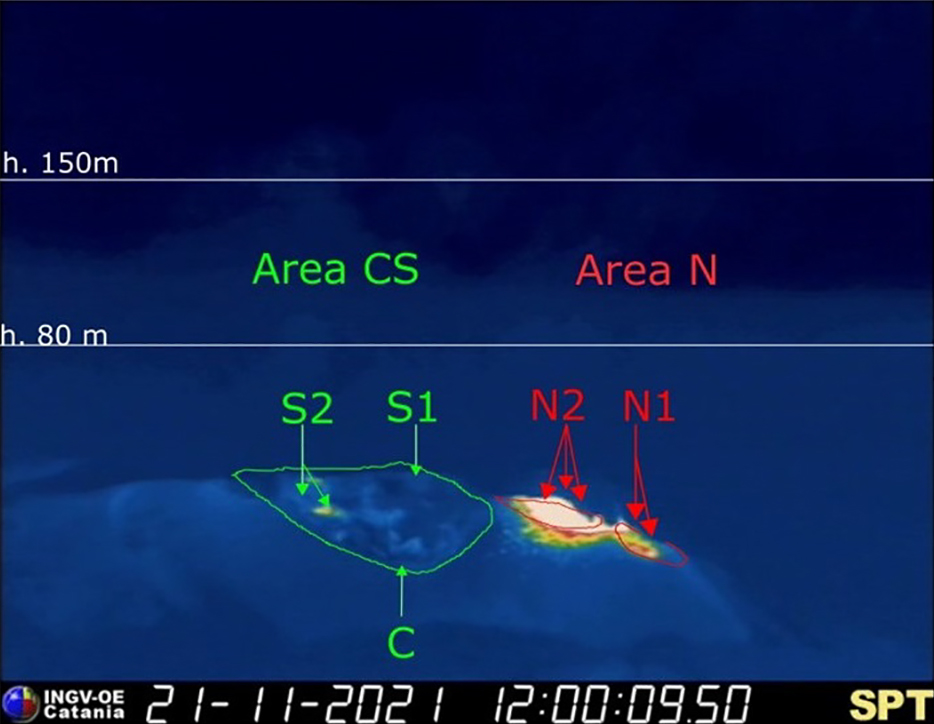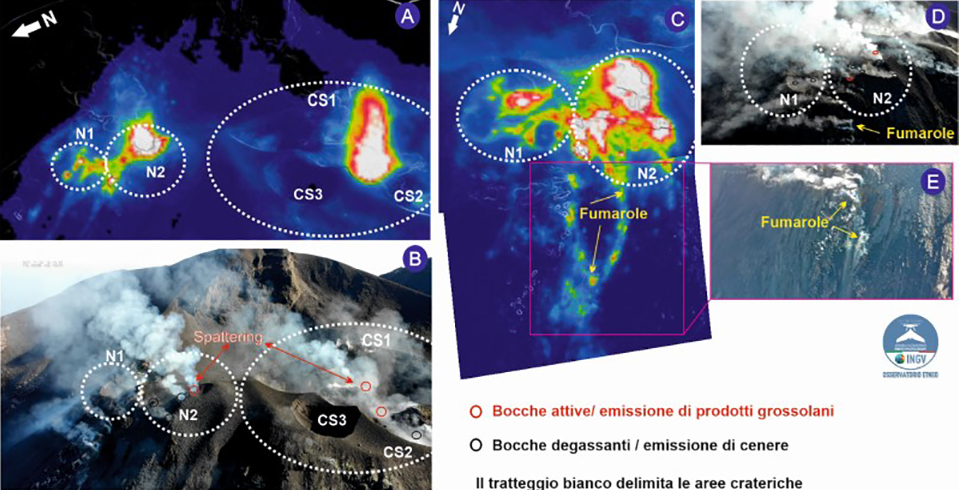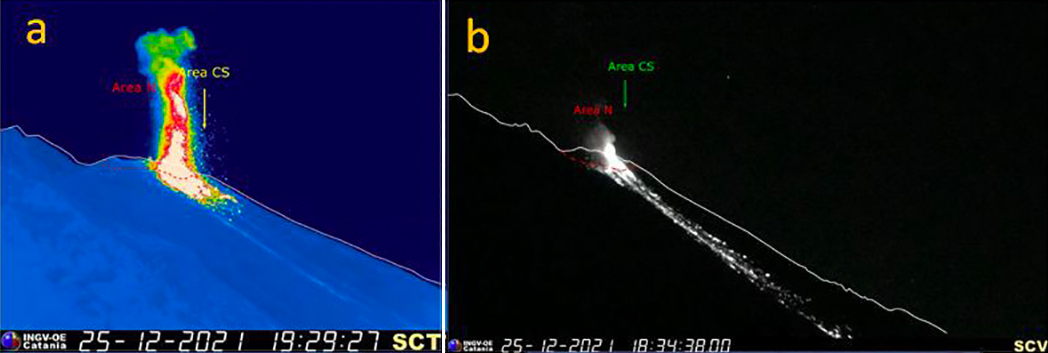Report on Stromboli (Italy) — February 2022
Bulletin of the Global Volcanism Network, vol. 47, no. 2 (February 2022)
Managing Editor: Edward Venzke.
Edited by A. Elizabeth Crafford.
Stromboli (Italy) Strombolian explosions and minor flow activity, September-December 2021
Please cite this report as:
Global Volcanism Program, 2022. Report on Stromboli (Italy) (Crafford, A.E., and Venzke, E., eds.). Bulletin of the Global Volcanism Network, 47:2. Smithsonian Institution. https://doi.org/10.5479/si.GVP.BGVN202202-211040
Stromboli
Italy
38.789°N, 15.213°E; summit elev. 924 m
All times are local (unless otherwise noted)
Nearly constant fountains of lava at Italy’s Stromboli have served as a defining character of this SE Tyrrhenian Sea volcano for at least 2,000 years; recorded eruptions go back to 300 BCE. Eruptive activity at the summit consistently occurs from multiple vents at both a north crater area (N area) and a central-southern crater area (CS area) on a terrace known as the ‘terrazza craterica’ at the head of the Sciara del fuoco, a large scarp that runs from the summit down the NW side of the volcano-island. Periodic lava flows emerge from the vents and flow down the scarp, sometimes reaching the sea; occasional large explosions produce ash plumes and pyroclastic flows. Thermal and visual monitoring cameras are on the nearby Pizzo Sopra La Fossa, above the terrazza craterica, and at multiple flank locations. Detailed information for Stromboli is provided by Italy's Istituto Nazionale di Geofisica e Vulcanologia (INGV) as well as several satellite sources of data; September-December 2021 is covered in this report.
Stromboli maintained typical levels of explosive activity throughout September-December 2021 with a modest increase in activity in the north crater area during November and December (figure 221, table 13). Thermal activity for the period remained low with a slight increase at the end of the year according to the MIROVA graph of radiative power (figure 222). Sentinel-2 satellite imagery also showed minor fluctuations in the number of active vents and in the amount of thermal intensity at the vents throughout the period (figure 223).
Table 13. Summary of type, frequency, and intensity of explosive activity at Stromboli by month from September-December 2021; information from webcam observations. Courtesy of INGV weekly reports.
| Month | Explosive Activity |
| Sep 2021 | Typical Strombolian activity, with discontinuous episodes of spattering. Explosions were reported from 3-4 vents in the N area and 5-6 vents in the CS area. The average hourly frequency of explosions was medium-low to medium-high (7-18 events/hour). Low (less than 80 m high) and medium (less than 150 m high) intensity explosions were typical for the first half of the month; high intensity events (over 150 m high) occurred during the second half of the month in both areas. High energy explosion on 11 September from N crater area. |
| Oct 2021 | Typical Strombolian activity, with discontinuous episodes of spattering. Explosions were reported from 3-4 vents in N crater area and 5-6 vents in CS area. The average hourly frequency of explosions was medium-low to medium-high (8-18 events/hour), rising to medium-high to high (15-24 events/hour) in the last week. The intensity of the explosions ranged from low to high in both areas throughout the month. Major explosion on 6 October from vent at N2 crater. |
| Nov 2021 | Typical Strombolian activity with spattering and lava flows. Explosions occurred at 5 vents in the N crater area and 4 vents in the CS area. The average hourly frequency of explosions was medium to high (10-25 events/hour). The intensity of the explosions was variable from low to high in the N area and low to medium in the CS area. Lava flows in the N crater area. |
| Dec 2021 | Typical Strombolian activity with spattering. Explosions were reported from 4-7 vents in the N area and 2-4 vents in the SC area. The average hourly frequency of explosions ranged from low to high (6-25 events/hour). The intensity of the explosions varied from low to high both areas. High level explosions on 25 December, minor flows. |
Activity during September-October 2021. INGV personnel made a site visit to the summit on 2 September 2021 to examine recent changes. In the N crater area, crater N1 had a cone with two vents and an inactive hornito, as well as three additional vents near the head of the Sciara del fuoco (figure 224). The observed explosions contained mostly ash and were of medium-low frequency and intensity. Crater N2 had at least two active vents that produced explosions of lapilli and bombs mixed with ash, but with very low frequency (less than 1 event/hour) and medium intensity. In the CS area, Crater C had three vents, two of which were degassing with no explosive activity. Crater S1 was an inactive cone. Crater S2 had two vents with pulsing emissions, a partly destroyed hornito, and a vent in a depression producing Strombolian explosions of lapilli and bombs mixed with ash. The event frequency was medium-low (5-10 events/hour) and the intensity was medium (the ejecta did not exceed 150 m in height). An additional cone facing the Sciara del fuoco was observed. At 1909 UTC on 11 September webcams recorded a high-energy explosive event that affected the N crater area. Cloud cover prevented detailed observations, but abundant fallout of pyroclastic material on the Sciara del fuoco was observed (figure 225).
A drone image from 23 September captured a view of the terrazza craterica showing both crater areas and the active vents (figure 226). During their site visit that day INGV noted that four vents were active at N1, with low frequency, medium intensity explosions of mostly ash. The active vent at N2 also had a similar frequency, intensity, and composition. At crater C in the CS area two vents issued pulsating gas emissions, and S1 had no explosive activity. Crater S2 had four vents, one with intermittent spattering activity. The explosions were low frequency with variable intensity of mostly lapilli and bombs.
Observations from the webcams (figure 227) throughout September 2021 indicated that crater N1 had two vents with low intensity explosions (less than 80 m high) of ash mixed with lapilli and bombs through 23 September. After this, the intensity of the explosions increased to medium and high values with numerous explosions exceeding 150 m in height. The N2 crater vent produced low intensity explosions of ash, lapilli, and bombs. Explosion frequency in the N area was 2-7 events/hour. In the CS area, crater S1 had no activity during the first week, but produced moderate to constant explosive activity of ash during 6-15 September before returning to sporadic explosive activity for the second half of the month. Three vents were active in crater S2 producing variable intensity explosions of mostly coarse material reaching and occasionally exceeding 150 m in height. Crater C had mostly intense degassing interrupted with modest explosions of lapilli and bombs during the second week of the month and on 25-26 September. The explosion frequency of the CS area fluctuated between 3 and 11 events/hour.
During October 2021 webcam images indicated that crater N1 had two active vents with variable intensity explosions of ash mixed with lapilli and bombs. A third vent with similar ejecta became active after 11 October. A number of the explosions exceeded 150 m in height during the last week of the month. Crater N2 also had two vents producing low intensity explosions of ash, lapilli, and bombs interrupted by a major explosion on 6 October. The northernmost vent in the N2 crater had continuous explosions on 2 October. A third vent was active in the N2 crater during 25-31 October, and intense spattering from N2 was observed during 27, 30, and 31 October. The explosion frequency at the N crater area ranged from 2-14 events/hour. At the CS area, vent S1 produced sporadic low intensity explosions of ash until 18 October. Sporadic explosions of lapilli and bombs recurred there during the last week of the month. The S2 area produced variable intensity explosions of lapilli and bombs from three vents. Crater C produced intense degassing interrupted by modest explosions of lapilli and bombs until 11 October when activity diminished. Explosions of lapilli and bombs at crater C occurred again on 23 and 26 October. The explosion rate in the CS area ranged from 4-12 events/hour.
A major explosion from a vent in the N2 crater began in the early afternoon of 6 October. The ejecta was sent in all directions out from the terrazza craterica, and also rose as high as the Pizzo Sopra La Fossa above the terrace. Numerous blocks rolled down the upper part of the Sciara del fuoco, creating a thick ash blanket on the slope. The explosion lasted for about ten seconds, and the subsequent ash plume was visible for about 20 seconds (figure 228). During a site visit on 9-12 October, INGV personnel carried out drone overflights to collect data for a new digital terrane model. Light and dark-colored meter-size ejecta appeared around the N1 crater from the 6 October explosion. A new crater with approximate dimensions of 37 x 47 m, was located between areas N1 and N2 (figure 229).
Activity during November-December 2021. Activity recorded in webcam data during November 2021 indicated that at the N1 crater had two active vents with medium-low intensity explosions of lapilli and bombs. Short periods of intense spattering were observed at the vent overlooking the Sciara del fuoco on 8 and 12 November. At the N2 crater, three vents produced variable intensity explosions of lapilli and bombs. Occasional intense spattering was noted on 3, 5-9, and 14 November, and became persistent after that. On 21 November a lava flow emerged from the crater in the N area that had formed during the 6 October explosion (figure 230). Additional flows during 25-27 November emerged from the hornito in the N2 crater. The average explosion frequency was 6-17 events/hour. In the CS area, during the first week of the month craters S1 and C had sporadic, low-intensity explosions of lapilli and bombs and then activity ceased for the rest of the month. Two active vents at crater S2 produced low intensity explosions of lapilli and bombs along with short periods of intense spattering. The explosion frequency in the CS area ranged from 4-10 events/hour.
A field inspection on 20 November 2021 by INGV personnel included drone imagery taken 400 m above the summit. Visible and thermal images captured the explosive activity at both crater areas. At least two degassing vents with minor ash emissions were observed at N1, and six vents with one spattering were noted at N2. At the CS area, two vents were spattering, and one was degassing. In addition, fumarolic activity was observed on the upper portion of the Sciara del fuoco (figure 231) aligned NNW with a length of about 60 m at the edges of both crater areas. On the morning of 21 November 2021 intense spattering from the vent between craters N1 and N2 produced a small blocky flow. Blocks rolled down the upper part of the Sciara del fuoco for approximately one hour. Beginning in the morning of 25 November, intense activity produced blocks of lava from a hornito in crater N2 that traveled down the Sciara. Intermittent flow activity continued through 27 November with pulses that sent blocks to the coastline multiple times (figure 232).
During December 2021 webcam images recorded explosions from crater N1 that were low to medium intensity from two vents with lapilli and bombs mixed with some ash. At crater N2 three vents produced variable intensity explosions of lapilli and bombs with weak and occasional spattering which increased in intensity on 12 December. Two more vents were active at N2 beginning on 13 December and intense spattering continued through 16 December. Some explosions in the N area reached 170 m high during 20-26 December and sent abundant ejecta onto the Sciara del fuoco (figure 233). Episodes of significant spattering during that week produced blocky flows that reached the upper part of the Sciara del fuoco. The average explosion frequency was 2-18 events/hour.
In the CS area, crater S1 had no significant activity for the month. Crater C had modest explosions of lapilli and bombs during 12-19 December but was otherwise quiet. Two vents were active at crater S2 with medium-low intensity explosions of lapilli and bombs at the beginning of the month. A third vent became active during the week of 13 December. The explosion intensity increased to high, with a number of explosions exceeding 150 m in height on 12 December. High levels of explosive activity at S2 during 20-26 December produced ejecta that rose as high as 190 m and consisted mostly of ash with lesser amounts of lapilli and bombs. The explosion rate was 0-7 events/hour.
Geological Summary. Spectacular incandescent nighttime explosions at Stromboli have long attracted visitors to the "Lighthouse of the Mediterranean" in the NE Aeolian Islands. This volcano has lent its name to the frequent mild explosive activity that has characterized its eruptions throughout much of historical time. The small island is the emergent summit of a volcano that grew in two main eruptive cycles, the last of which formed the western portion of the island. The Neostromboli eruptive period took place between about 13,000 and 5,000 years ago. The active summit vents are located at the head of the Sciara del Fuoco, a prominent scarp that formed about 5,000 years ago due to a series of slope failures which extends to below sea level. The modern volcano has been constructed within this scarp, which funnels pyroclastic ejecta and lava flows to the NW. Essentially continuous mild Strombolian explosions, sometimes accompanied by lava flows, have been recorded for more than a millennium.
Information Contacts: Istituto Nazionale di Geofisica e Vulcanologia (INGV), Sezione di Catania, Piazza Roma 2, 95123 Catania, Italy, (URL: http://www.ct.ingv.it/en/); MIROVA (Middle InfraRed Observation of Volcanic Activity), a collaborative project between the Universities of Turin and Florence (Italy) supported by the Centre for Volcanic Risk of the Italian Civil Protection Department (URL: http://www.mirovaweb.it/); Sentinel Hub Playground (URL: https://www.sentinel-hub.com/explore/sentinel-playground).

